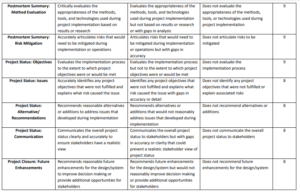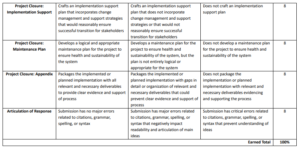Solved: IT 420 Milestone Two Guidelines and Rubric (Draft of Project Closure Document)
In this milestone, you will submit a draft of the project closure document (Section III). Your draft project closure document must contain a postmortem summary, project status, future enhancements, implementation support, maintenance plan, and appendix as described in this document. Also, be sure to describe how you incorporated any feedback that you received. Prompt: Specifically, the following critical elements must be addressed: III. Project Closure a) Postmortem Summary: An important part of information technology (IT) system development is to capture what worked well and what did not. You should be able to effectively communicate this to stakeholders during a project closure meeting and effectively document this to be referenced as a learning opportunity by other IT developers. 1. Methodologies: Articulate the methods you used, or would use, for full implementation of your project design. These should speak to the methods and techniques identified in your planning stage from IT 415. 2. Method Evaluation: Evaluate the appropriateness of the methods, tools, and technologies used during project implementation based on the results or based on research evidence in the event you cannot implement your project. 3. Risk Mitigation: Articulate any risks that need to be or would need to be mitigated so that future developers can anticipate these risks in similar projects. b) Project Status: In this section, discuss the status of your project. You will describe whether it is fully complete and evaluate the effectiveness of the system design. 1. Objectives: Evaluate whether or not the objectives stated in the original project proposal were met, including those to ensure the design meets organizational/user needs in the long-term. If you cannot implement your proposal, evaluate your implementation plan for its potential to lead to meeting the objectives based on research. 2. Issues: Identify any project objectives that were not fulfilled and explain the risks that prevented fulfillment to inform stakeholders of completion risk, mistakes, and so on. 3. Alternative/Recommendations: If a shortcut or alternative to the planned design was implemented to allow the project to move forward, describe what this was and whether or not it should be corrected or improved in a future version for development. If you could implement your design without any changes, defend your design in terms of ease, efficiency, and effectiveness. It is unlikely that you will be able to fully implement without adjustment to your design, however, so if you did not make changes, defend your reasoning. In the event you could not implement your design, discuss what limited your process and the recommendations you might have for success in the future. 4. Communication: Communicate this section effectively so that stakeholders have a realistic, accurate view of the project’s status. c) Future Enhancements: Recommend future enhancements for the design/system that may further improve decision making or provide additional opportunities for your organization or stakeholders. This could include ideas for developing the system to be used for additional domains or operating environments as well as other uses for the system. d) Implementation Support: Craft a support plan for implementation that will ensure successful transition for stakeholders, users, and others. Describe change management and support strategies that can be implemented if your IT project/system was used in a real-world environment. e) Maintenance Plan: Develop a maintenance plan for your design/project that will help to ensure the health and sustainability of the system. Use research to support your conclusions where appropriate. f) Appendix: Package the design from IT 415 and the various deliverables, documentation, graphics, and other elements in the appendix to provide supportive evidence for the verification plan and for elements A through F of the project closure document. The items included in your appendix may vary depending on the type of project you chose to complete, but some examples could include: 1. All executable files and source codes 2. Various documentation associated with implement support 3. All associated webpage and script files for a website. Provide the URL if the website is hosted on a server. 4. Screenshots or video that demonstrate implementation 5. Network diagram with photo images/screenshots that prove implementation 6. Narrated presentation that presents the implemented system 7. Associated database files and data 8. Prototype files 9. Simulation and/or evidence of simulation running Rubric Guidelines for Submission: Submit assignment as a Word document with double spacing, 12-point Times New Roman font, and one-inch margins.



